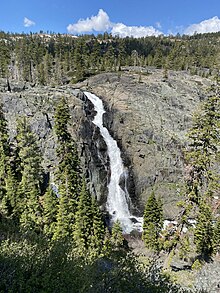Feather River
These and other tributaries drain part of the northern Sierra Nevada, and the extreme southern Cascades, as well as a small portion of the Sacramento Valley.
In terms of drainage area, the largest is the North Fork, which drains about 60% of the entire upper Feather River watershed.
From there the river flows generally south across the Sacramento Valley, east of the Sutter Buttes, past Oroville and Yuba City–Marysville.
The North Fork flows southeast into Butte County, becoming the northern arm of Lake Oroville.
The total length from the mouth of the East Branch to the source of Last Chance Creek is about 89 miles (143 km).
[7] The Middle Fork Feather River begins at 39°48′49″N 120°22′46″W / 39.81361°N 120.37944°W / 39.81361; -120.37944, in southeastern Plumas County about 0.5 miles (0.80 km) south of Beckwourth, at the north end of the Sierra Valley.
[22] It is formed by the joining of a number of tributaries that merge in an inverted river delta wetland with a complex network of irrigation ditches and drains called the Sierra Valley Channels.
[13][21] Flowing west through the mountains from its source in the Sierra Valley the Middle Fork is joined by Big Grizzly Creek, which drains Lake Davis to the north.
Continuing west, the Middle Fork passes between Graeagle and Blairsden and further downstream south of Sloat in Long Valley.
It flows southwest through Snag Lake and by Coon Hollow, after which it is joined by Philbrook Creek, which drains Philbook Reservoir to the east.
The diverted water flows into Hendricks Canal, a 8.66-mile (13.94 km) long conduit composed of ditch, flume, and tunnel sections, with a capacity of 125 cubic feet per second (3.5 m3/s).
[26] Another diversion dam on the West Branch Feather River near Magalia, called the Magalia 73 Dam, conveys water into the Upper Miocene Canal, which runs to Kunkle Reservoir and the Lime Saddle Powerhouse on Lake Oroville.
The Miocene Canal and Lime Saddle Powerhouse are part of the DeSabla Regional Bundle of hydroelectric facilities operated by the Pacific Gas and Electric Company.
[13][21] The United States Forest Service manages over 80% of the Feather River's upper watershed, in the mountains above Lake Oroville.
[12] In terms of drainage area, the North Fork Feather River is the largest, accounting for about 60% of the total basin above Lake Oroville.
The Sierra Valley comprises an area of about 590 square miles (1,500 km2)[29] is located where a number of tributaries come together to form the Middle Fork.
Historically, American Valley was a floodplain, but settlers drained the wet meadows to create pasture for cattle and fields for hay production.
The Western Pacific California Zephyr trains used this route and had a feather in their logo to represent the river.
At about 770 feet (230 m) high, it is the tallest dam in the United States and wields nearly complete control over the flow of the Feather River by creating one of the largest reservoirs in California.
The dam was built with the purpose of preventing the frequent floods that often inundated this part of the Sacramento Valley, and to store water for agricultural uses downstream during the dry season.
The dam is the principal feature for the California State Water Project, storing water for more than 23 million people and 750,000 acres (300,000 ha) of farmland in Central and Southern California Directly downstream from Oroville Dam lies the Oroville-Thermalito Complex, which consists of two reservoirs, a Forebay and Afterbay, both used for hydroelectricity generation.
The Feather's main tributaries, the Yuba and the Bear, are also impounded by large dams that provide irrigation water and flood control.
Smaller dams now also block other tributaries, including the Middle, South and North Forks of the Feather.
The watershed's high mountain streams are often utilized in complex schemes for hydroelectricity generation, including the Pacific Gas and Electric Canyon Power Project on the North Fork, which uses water from Lake Almanor, and the Yuba Hydroelectric Project which taps the Middle and South Forks of the Yuba River.
From 1969 to 2009 the average flow is 1,086 cubic feet per second (30.8 m3/s), mainly due to diversion for power generation at the Thermalito pumped-storage plant.
[33] The riparian area of the Feather River supports a rich biodiversity of native flora and fauna.
The Sierra Nevada reaches have considerable wild river features and steep gradients.
In lower reaches, after joining of the forks, there is also significant habitat; near Yuba City, for example, there are extents of the river with numerous valley oak trees with understory of wild grape.
The California Office of Environmental Health Hazard Assessment (OEHHA) has developed a safe eating advisory for the upper[34] and lower[35] sections of Feather River based on levels of mercury found in fish caught from this water body.


